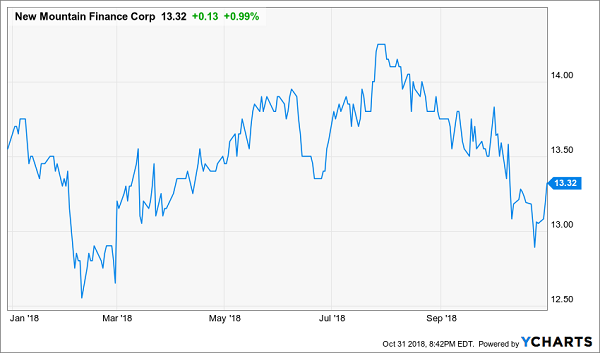When it comes to dividends, any stock yielding more than 10% these days needs to be taken with a grain of salt. That’s because bigger isn’t usually better when you’re talking about dividend yields.
Any income investment can be priced relative to government interest rates, currently between 2% and 3%, depending on how much extra risk you’re willing to take on.
Historically-speaking, any time a stock is paying more than seven percentage points above the AAA-rated, government-secured debt, investors begin to worry if the dividend could be cut.
However, following the 7% loss suffered by the S&P 500 in October, more stocks are sporting a double-digit yield that at any other point in 2018.
With that in mind, I’ve highlighted two dividends above 10% that appear secure enough to buy, following the recent market decline.
Worthwhile 10%+ Yielder No. 1: Demand and Dividend Rising
 Alliance Resource Partners (ARLP) is a coal limited partnership that is the largest operator in the Illinois Basin, where the product naturally burns cleaner for the amount of energy that’s created.
Alliance Resource Partners (ARLP) is a coal limited partnership that is the largest operator in the Illinois Basin, where the product naturally burns cleaner for the amount of energy that’s created.
The stock offers investors a rare opportunity. The company pays a quarterly distribution $0.525 a share (10.8% dividend yield) that management has actually boosted the payout six straight quarters.
Any commodity business boils down to supply and demand and Alliance Resource is currently in the catbird seat. Management is planning to set increase production by 8% this year and another 6% to 10% in 2019, to keep up with higher coal demand outside of the U.S.
The company earned $0.55 a share in the third quarter, which covered the dividend, aided by higher coal demand. Management has also been buying back shares, but history shows the supply/demand balance is delicate in all commodity markets and can quickly reverse.
Worthwhile 10%+ Yielder No. 2: Savvy Investor Leveraged to Rising Rates
 New Mountain Finance (NMFC) is a business development company (BDC) that invests primarily in technology, healthcare and other non-cyclical industries. The company pays a steady quarterly dividend of $0.34 a share (10.2% yield) that management has covered every quarter with net investment income (NII) since going public in 2011.
New Mountain Finance (NMFC) is a business development company (BDC) that invests primarily in technology, healthcare and other non-cyclical industries. The company pays a steady quarterly dividend of $0.34 a share (10.2% yield) that management has covered every quarter with net investment income (NII) since going public in 2011.
In addition, New Mountain is leveraged to benefit from rising interest rates. 86% of the company’s debt investments are floating-rate and the majority of its debt financing is at fixed rates. As a result, management estimates that annual NII will grow by $0.10 a share, for every 100 basis-point rate increase.
Like a lot of BDC’s, New Mountain will soon increase its maximum capital leverage to 2:1, thanks to favorable government regulations. This coupled with the company’s exposure to rising interest rates, has led to a consensus profit expectation for 6% average annual earnings growth over the next three years.
It’s also worth noting that chief operating officer John Kline bought 17,250 shares of New Mountain on the open market back in September. There are several reasons why company insiders may sell shares, but they usually only buy when they believe the business is headed in the right direction.
The sharp market selloff in October has created some potential buying opportunities, but chasing double-digit yields remains a risky business. A stable dividend yield of 10% is nice, but there are far more landmines than potential winners in this space.
— David Peltier
Sponsored Link: The good news is: there’s a better way. There are better bargains to be had, for secure 7% to 8% yields with upside potential and monthly payouts to boot.
My colleague Brett Owens can show you how. He has created an “8% No-Withdrawal Portfolio” that generates steady income and impressive capital gains.
Whether you’re already retired, or looking to augment your paycheck with the passive income that dividends afford, you no longer have to choose between measly 2% to 3% yields from dividend “aristocrats”, government-secured interest payments that barely keep up with inflation and dicey double-digit dividends.
Wall Street has tried to address this issue with structured products, such as single premium immediate annuities (SPIAs). But just like the casinos don’t pay for all the glitz and glamour because gamblers usually win, the big financial service firms charge hefty fees to provide you with that steady income.
Instead, Brett’s system could hand you $40,000 a year on every $500,000 invested with under-appreciated income plays like:
- Closed-End Funds (CEFs)- We’ll share our top three CEF picks with you, each of which pay a monthly dividend (all the way up to 9.4%) and trade at a discounts to net asset value you’ll never find among ETFs.
- Preferred Stock- Brett reveals two of the best active managers in this space to invest alongside with.
- Recession-Proof REITs- discover two REITs (paying 7% or better) that actually benefit from higher interest rates; rather than being crippled by the Fed.
That’s 7 contrarian investment picks just to get started. Click here for instant access to the full 8%, No-Withdrawal portfolio.
Source: Contrarian Outlook


